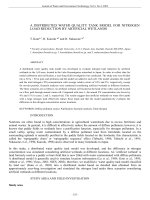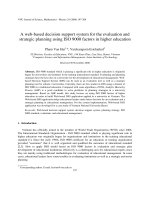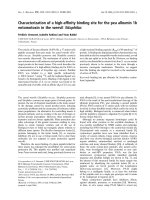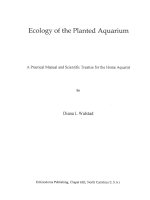Establishing a surface water quality monitoring network for the Mekong delta,Viet Nam
Bạn đang xem bản rút gọn của tài liệu. Xem và tải ngay bản đầy đủ của tài liệu tại đây (716.82 KB, 26 trang )
Establishing a surface water quality monitoring network
for the Mekong delta,Viet Nam
1
PROPOSAL ON
ESTABLISHING A SURFACE-WATER QUALITY MONITORING NETWORK
FOR THE MEKONG DELTA, VIETNAM
prepared by
College of Technology, CanTho University, Vietnam
(Version 22 July 2004)
--- oOo ---
I. INTRODUCTION AND RATIONALE
1.1 The Mekong Delta and its main environmental problem
Mekong River, the 11
th
largest river in the world, is the main water source for irrigation, fishery,
and domestic use… In short, the living of the whole population in the Mekong Delta (MD) is
depending and will be depended on this resource.
The MD of Vietnam is located at the most downstream part of the Mekong river basin. With a
population of 17 million inhabitants living in 4 million hectares of land, the MD has great
potentials for agricultural production. The MD is the most important agricultural production
region for the whole country. It supplies for more than 50% of staple food and 60% of fish
production and accounts for 27% of the total GDP of Vietnam. Rice and fishery products
contribute significantly to the nation’s export earning.
The MD is a typical river delta, with a dense water system of natural creeks, small rivers.
Besides, artificial canals for irrigation, drainage and navigation have been constructed
throughout the whole region. Farmers, accounted for 85% of the total population, are living in
communities, which are split into small parcels, along the waterways. Only 30% of them can
access to safe water, the rest using directly surface water at the rivers or canals. Unfortunately, as
the consequences of a fast-growing economy, which is strongly based on agriculture, the region
is facing more and more severe environmental problems like pollution of water resources by
pesticides, fertilizers and animals manure, etc., especially since the past ten years. While most of
local farmers have to depend totally on the surface water for drinking, irrigating their crops,
fishing, aquaculture, etc., protection of this water source is crucial to ensure sustainable
development of the MD. Recognizing this urgent issue, recently the Vietnamese government has
promulgated two important decrees in order to protect the water resource. These are:
The decree No. 200 of the Prime Minister dated April 4
th
, 1994
The decree No. 36 CT/TW dated June 25
th
, 1998.
However, the surface water quality in the MD is still changing in the complicated way due to
following:
1.2 Problems related with water
Located at the downstream end of the River, the MD will face all possible impacts from
upstream activities, which cause changes in quantity and/or quality of water (Ta Quang Ngoc
2000).
2
Surface-water quality problems are classified according to natural conditions due to topography
and geology of the delta. The development of the delta at the moment and in the near future,
beside positive impact, will also lead to environmental pollution. Development of agricultural
sector and urbanization are main issues affect the water quality. Use of excess and improper of
fertilizer leads to enrich water body by nutrients together with poor drainage in impression areas
in the MD, will impair water quality. Trophic state of water body at present is in hypertrophic
level; in addition the use of pesticide, fungicide, insecticides is not controlled. Most of micro-
organic pollutants are DDT, DDE, Dieldrin…
Rapid urbanization in some rural areas, combined with backward behaviors as making on the
canal overhung latrines, directly discharge of domestic wastes to canal system without any
treatment and others cause oxygen deficiency in water body.
1.2.1 Problems on water quantity
1. Shortage of fresh water for irrigation in the dry season
In 1999, a total area of 1.4 millions ha of spring-rice crop (dry season crop) needs irrigation.
Water demands are increased proportional with rice cultivation areas. From 1995 to 1999, newly
reclaimed areas available for rice cultivation has increased by 105.000 ha/year (Statistical
Yearbook 2000).
The main thrust of water resources development may be on-farm development and canal
improvement (enlargement of existing, and construction of new primary and secondary canals)
to bring more irrigation water to the already irrigated areas and to improve drainage conditions
and promote flushing of acid water. Embankment improvement in the deeply flooded areas could
prevent flooding till the end of August. In the shallow flooded, already more developed areas;
full year round protection is possible.
Both rainfall and river flow have a pronounced seasonal patterns. Periods of water excess
alternate with periods of water shortage, and water control measures must essentially adapt to
this regime feature. Virtually the only source of water for irrigation is the Mekong River, which
can with relatively minor improvements of the existing canal system, be channeled to all part of
the MD except for the southern and western part of the Ca Mau Peninsula. The discharges of the
Mekong river system are adequate to meet the irrigation water requirement during the early part
of the dry season and in June, a month with frequent dry spells after the start of the wet season.
However, during the March – May period, Mekong discharges are low and are required to
prevent deep saline water intrusion. Higher rates of abstraction would increase salinity intrusion
which is already affecting large areas.
2. Flood
An area of 1.2 to 1.9 millions ha of the MD is under annual floods. The severity degree and
frequency of the floods is increased. Within the past forty years, four substantial floods have
occurred in the following years: 1961, 1978, 1991 and 2000.
During the period of high river discharges, the banks of the Mekong river system are overtopped
on a large scale and the land is inundated. This inundation usually starts in July /August ands in
November/December. As there is considerable attenuation of the river water levels and
progressively increased capacity of the river system downstream, the river flood inundation
decrease downstream. In the south, excess rainwater also leads to large-scale inundation of the
land outside the river-flooding zone. This occurs especially in the southwestern part of the MD,
3
typically in June/July. Large areas remain waterlogged and inundated for most of the rainy
season.
In view of the limitations on land use imposed by excess water due to flooding and rain, the dry
season is the main crop production season. The discharges of the Mekong river system are quite
adequate to meet the irrigation water requirements of the Delta during the early part of the dry
season. However, during the February ÷ May period Mekong discharges are low. Appreciable
net outflow from the Delta is required to prevent deep saline water intrusion. The river and canal
water in many parts of the coastal area is too saline to be used for irrigation purposes. The
affected zone is rather small at the beginning of the irrigation season, but irrigation intake points
become affected as the salinity intrudes further inland in parallel with decreases in net outflow
from the MD.
Acidification of canal water is a problem in areas with large concentrations of acid sulfate soils;
especially during May ÷ July when the acids from the soil enter the canals with drainage of the
early rains. Acidification of canal water can in general be managed by providing adequate
through-flow in the effected area, but as reclamation of acid sulfate soils progresses this may not
longer hold true.
The subsoil of the MD contains huge quantities of groundwater. Its exploitation, however, is
constrained by 3 factors: (1) the quantity of the water in the five aquifer, mainly salinity, (2) the
permeability of the aquifers, and (3) the fresh water recharge of the aquifers, which determine
the safe yield. However, when considering the expected urbanization in the MD, this quantity is
actually small. It should therefore be reserved for urban and rural water supply use only,
predominantly for rural areas and town that cannot avail of good quality surface water.
1.2.2 Problems on water quality
1. Acid sulfate soils
In large parts of the MD, clayey sediments deposited under brackish or saline conditions contain
soluble sulfates. In these, sulfate-reducing bacteria convert the sulfate to sulfides under anaerobic
conditions. This result in the formation of hydrogen sulfide – a highly toxic gas – and iron
sulfide, pyrites, FeS
2
, an insoluble non-toxic compound.
Acid sulfate soils, form when soils containing iron sulfide are exposed to oxygen, cover 1.6
millions ha (40%) of the MD (Minh et al. 1996). Soils with high iron sulfide content do not
usually become a problem so long as the soil remains inundated (Brinkman, Ve, et al. 1993).
Agricultural activities in the acid sulfate soils, especially in the large scale in the 2 severely acid
regions, Plain of Reeds and Long Xuyen Quadrangular (with a total surface area of more than 1
million ha), major cause of water pollution in the region.
The most significant detrimental properties of acid sulfate soils are:
• Release of acid (and sometimes toxic) drainage water which causes detrimental impacts
on the environment downstream.
• Fixation of phosphorus in the form of insoluble aluminum or iron phosphate. This locks
up phosphate from surface and groundwater, leading to phosphorus deficiency and a fall in
primary productivity.
2. Salinity intrusion
Salinity intrusion is the most important effect that influences water quality in the MD. Currently,
1.7 millions ha of the delta (42%) is under salinity intrusion (SIWRMP 1995). Salinity intrusion
is the principal limit factor of agricultural production (most of the are is under mono-crop of
4
rice), where located most of the poor provinces with a high ratio of poor farmers. Shortage of
drinking water is another diversity for local people. In order to prevent further salinity intrusion,
it is necessary to keep flows from dropping too low (WB-ADB 1996).
The reduced freshwater flows allow salt water to penetrate further upstream into the estuarine
channels, changing the chemical environment and causing substantial changes in the species
composition of the local ecological communities. A major effect has been to reduce the growth
of the littoral brackish forests which help to bind the soft silt soils, and this permits enhanced
erosion rates of the seaward coastline in many areas of the MD.
The delta experiences severe salt intrusion through channels and creeks, reaching a peak in
April/May, corresponding to the end of the dry season and the lowest flows in the Mekong river
system. In some areas, salinity has led to the contamination of the sweet water in near surface
aquifers, to the point at which it is unfit for consumption.
3. Pathogenic pollution and public health problems
Domestic wastewater contains pathogenic bacteria, viruses and parasitic organisms which
originate from human and animal waste. Conventional physical and biological sewage treatment
processes, when available reduce the number of these organisms, but the large number remaining
represent a severe public health hazard.
Especially at risk are people who use the water for cooking, washing and bathing in
contaminated waters. Also at serious risk are those who consume fish, shellfish and other aquatic
animals and plants that have accumulated pathogens from the water in which they live. Shellfish
grown in polluted waters are particularly liable to infect consumers, since they filter large
volume of water in feeding and may be consumed raw or after insufficient cooking.
During the dry season, there is in many areas in the delta a serious lack of drinking water. The
water quality of the surface-water of the delta has a tendency to get worse when going
downstream. Because of rapid urbanization in the Delta that leads to high population densities.
The low basic sanitary condition, in form of overhung latrines above public channels and
fishponds it is expected that the surface-water contain high concentrations of fecal coliform
bacteria. Most of wastewater is diverted directly into the rivers and the canals. In addition,
people living along the rivers and the canals or in boats dispose solids and liquid waste into the
water. Besides, feeding fish by night soil in the fishponds connected to the rivers or canals is a
popular economic source which makes the surface-water contaminated. As many people in the
area drinks straight from the surface water, enteric infections and diarrhea diseases are widely
spread in the area.
If appropriate measures are not taken to reduce the discharges of domestic waste products into
the ambient environment, then probably the capacity of the nature to decompose and turnover
these waste products will be exceeded in the near future. This assumption is based on the
dramatically increase in the growth of population in the past 20 years. The development of the
MD in the near future is expected in high rate in which urbanization will cause serious
degradation of water quality.
4. Organic pollution
Besides causing aesthetic water pollution problems, dumping or discharge of organic matter into
receiving water bodies also creates oxygen deficiency. After being discharged into the water the
5
organic matter starts decomposing. This process is oxygen consuming and temperature
dependent and the high temperature in the Mekong River system all the year around will
accelerate this process. If the receiving water bodies do not have the oxygen renewal capacity
which is required to accommodate the amount of discharge organic matter, oxygen depletion can
result in killing of fish and other aquatic organisms which depend on oxygen from the water
itself. The variation of dissolved oxygen is quite various at different sites in the MD.
Oxygen saturation levels in the relatively high temperature water of the Mekong River system
are comparatively low, and an average BOD of 3 mg/L corresponds to actual concentrations of
dissolved oxygen of only around 5 mg/L. Many river fish become respiratory dependent at or
near this level. This means that the hemoglobin in their blood is unable to carry its full potential
loading oxygen, and this may alter their ability to survive or compete with others less affected.
So apparently harmless low levels of organic pollution may still have substantial environmental
impacts at the species level. If adversely affected species are significant in human diets, then
there may be negative impacts on human nutrition and health.
5. Agro-chemical pollution
Nutrients such as nitrogen and phosphorus are essential for the growth of all plants. Discharge of
nutrients into the rivers might be beneficial to the growth of algae and seaweeds and thus to other
aquatic biota as well as for irrigation purposes. High concentrations of nutrient from domestic
sewage and industrial effluent or excess fertilizer runoff from cropped areas into rivers might
result in dense algal growth and eutrophication problems.
In eutrophic (nutrient enriched) conditions, the ability of the heavy blooms of phytoplankton to
detoxify organic and some inorganic contaminants may be very high.
Whilst this may appear reduce the environmental risks from toxic pollutants, the subsequent
incorporation into the food chain after the algae have been grazed by zooplankton and larger
herbivores, with its attendant probability of unpredictable biological accumulation at higher
trophic levels, raises other risks to the stability of the dynamics of the ecological communities.
These may include selective mortality of species and unquantifiable – but nevertheless, very real
– public health hazards.
Every year, floodwater inundates a great part of the delta area and carries biocide residues into
the river system for dispersal into the sea at the coast. However, the picture is complicated by the
common practice of adulterating these expensive chemicals with large quantities of cheaper and,
fortunately, usually much less toxic adulterants.
In all estuaries, the relatively short zone in which the fresh/saline water interface ebbs and
follows with each tide represents an efficient “nutrient trap”, in which many minor chemical
contaminants become concentrated. Because of the uncertainty of the actual active ingredient
concentration of these materials, and the poor records of their use, no reliable data on the
potential risks to the general inland environments can be calculated. There is an urgent need for
monitoring their presence in the estuarine nutrient trap zones, since their effects on communities
in this zone may be far more significant than in many other habitats.
6. Hazardous substances pollution
Dumping of solid waste products in landfills will always create a potential risk of leaching of
environmentally hazardous substances and contamination of groundwater and surface waters.
Discharge of industrial wastewater which contains toxic substances and accidental spill of
chemicals during transportation may result in serious environmental pollution. Toxic substances
6
that will accumulate in the environment, such as certain metals, pesticides and other organic
substances resistant to bio-degradation, require particularly cautious regulation since their effect
may be irreversible or present hazards to consumers of the water, i.e. for drinking or aquatic
organisms.
At present the MD is not detrimentally impacted due to discharges of industrial waste products.
However, in near future with rapid development in the region, this should be taken into
consideration, the responsible environmental authorities has to establish an industrial
management plan aiming at protection the environment against industrial discharges.
Annually, Department of Science Technology and Environment (DOSTE) of 11 provinces in the
MD organized two campaigns for monitoring surface-water quality. Those activities are useful
when they want to observe about surface-water quality in their basin. In addition, those results
could be used to orient the development of their provinces. However, the results of this campaign
could not be used in the effective way because of the following reasons:
• The sampling and analyzing techniques are varied from province to province.
• There is not a common format for managing the data.
As the consequent, up to now, the whole picture of the water pollution evolution of the MD
cannot be drawn. Recognizing the urgent need of the establishment of a Water quality
monitoring network for the MD that use the unified technique and data base for sharing the
information, Cantho University (CTU), the center of education and research in the MD (see
annex) is writing this project proposal calling for support.
7
II. OBJECTIVES OF THE PROJECT
2.1 Overall objective
Establishing the Mekong Delta Water Quality Monitoring Network in which CTU will be the
center of this network. The members of this network are CTU and DOSTEs in the MD, other
institutions in the countries along the Mekong River. These members will use the same analysis,
sampling methods and equipment. They will build a unified database for recording and sharing
data. The data will be used for prediction the change of surface-water quality in the MD.
2.2 Specific objectives
1. Increasing the awareness of DOSTEs about the problem of existing surface-water quality
monitoring activities and the need of establishment a surface-water quality network.
2. Enhancing the co-operation between eleven DOSTEs and CTU in surface water quality
monitoring by establishment a surface water quality network in which CTU is the center.
3. The monitoring network will use the same equipments, sampling methods, analyzing
methods.
4. Upgrading the capacity of lab technicians.
5. Establishing unify database for recording and sharing collected data.
6. Establishing a model for predicting the trend of water quality in the MD.
8
III. ACTIVITIES
3.1 Partner coordinator missions to Vietnam
Term of Reference:
• Identification of project feasibility
• Discussion on project management aspects
• Need assessment: expert missions, training subjects, resources, etc.
3.2 Initiative workshop in Vietnam
Target group:
• Leaders, representatives of DOSTEs and Environmental Monitoring Station.
• Staff of CTU who are teaching, doing the research on environmental issues
Experts:
• Experts from partner side
• Experts of CTU
3.3 Training in Vietnam
Topics:
• Sampling methods
• Analyzing methods, especially the ones that are suitable with used equipments.
• Applied GIS to Water Management
3.4 Training in foreign country
2 MSc. in:
• Applied Informatics in Water Quality Monitoring
• Water Quality Management
3.5 Lab equipments
The following equipments need to be equipped for the labs:
pH meter
DO meter
Microorganism incubation chamber
Sterilizing chamber
Vacuum filtration set (for Suspended solid analyzing)
Spectrophotometer (Hatch DR 4000)
BOD incubator
Hand-held GPS
Computers
3.6 Library and Information Unit
A bookshelf specializing on Water Resources Management to provide information to staff for
their monitoring activities will be established. The information unit with a server for update and
share the monitoring result will be establishes at managed at CTU.
9
3.7 Monitoring
Twice a year the DOSTEs will organize the monitoring campaigns. The analyzing result will be
recorded in the same format and send to information unit. The data will be processed by the
experts of information unit then shared to the members of the network.
IV. EXPECTED OUTPUTS
1. A water quality-monitoring network for the MD.
2. Qualified staff members (2 MSc., and 24 lab. technicians) specializing on water quality
management, water quality monitoring, water quality analysis, computer network development
and maintenance.
3. Well and synchronous-equipped Water Quality analysis Lab.
4. Information unit that can process and share the data to the members of the network.
5. Water quality computer models modified and adjusted to the conditions in the MD.
V. DESCRIPTION OF PARTNER INVOLVED IN THE PROJECT
Foreign partner: ……………………….
Vietnamese partner:
• Project leader: Prof. Le Quang Minh, Vice Rector, Dean (Dr. in Agricultural and
Environmental Science, Wageningen University, Netherlands)
• Coordinator: Mr. Le Hoang Viet, Director, Environmental Engineering and Renewable
Energy Center, Vice dean, College of Technology, Cantho University (MSc. in Environmental
Engineering, AIT, Bangkok, Thailand)
• Member: Mr. Nguyen Hieu Trung, Vice Director, Environmental Engineering and
Renewable Energy Center, Cantho University (MSc. in GIS, International Technology Center,
The Netherlands)
• Member: Mr. Le Anh Tuan, senior lecturer, College of Technology, CTU (MSc. in Water
Resources Engineering, AIT, Thailand)
• Member: Mr. Nguyen Vo Chau Ngan, lecturer, College of Technology, CTU (MSc. in
Sanitary Engineering, Catholic University of Leuven, Belgium)
• Members: representatives of DOSTE of eleven provinces in the MD









